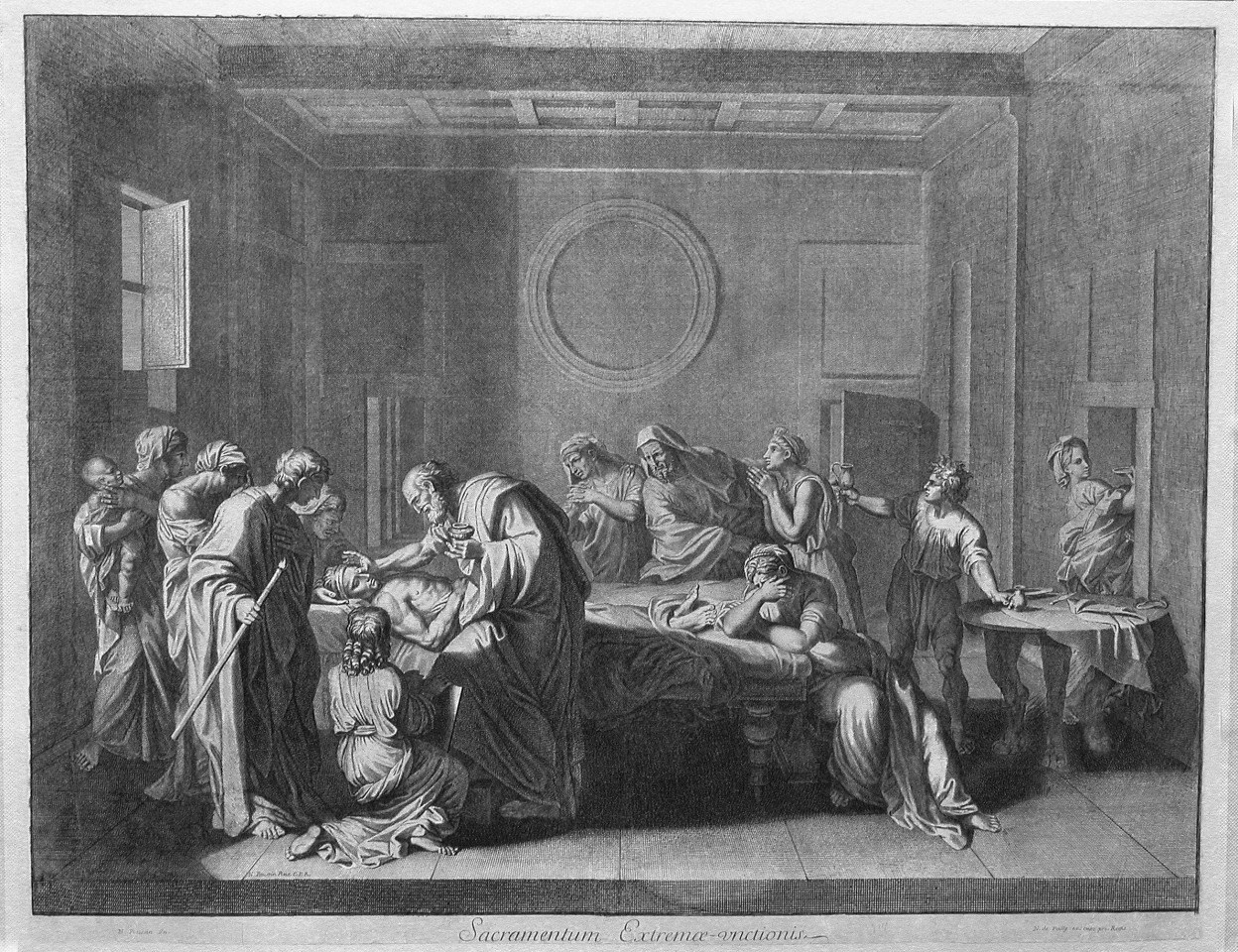Sacramentum Extremae-unctionis ; Sakrament Ostatniego Namaszczenia
Sacramentum Extremae-unctionis ; Sacrament of Extreme Unction
Louis de Châtillon (1639-1734) - Nicolas de Poilly (1627-1696 )
Miedzioryt z akwafortą. Sygnatury: l/d. N. Poussin In.; l/d. na obrazie N. Poussin Pinx. C.P.R; p/d. N. de Poilly ex. cum pri. Regis
Engraving with etching. Caption: Lower left corner: N. Poussin In. Caption: Lower left within the image: N. Poussin Pinx. C.P.R. Caption: Lower right corner: N. de Poilly ex. cum pri. Regis
Wymiary: odcisk płyty 512 x 658 mm, karta 634 x 888 mm. Grafika przeniesiona na podkład z bibuły.
Dimensions: image 512 x 658 mm, sheet 634 x 888 mm. Print is trimmed within platemark and pasted on paper
Louis de Châtillon (1639-1734) – Nicolas de Poilly (1627-1696 )
Grafika Sacramentum Extremae – unctionis – Ostatnie Namaszczenie powstała według obrazu „L’Extrême-onction” Nicolas Poussin (1593/4 – 1665) a wzorem dla niej była wcześniejsza grafika – akwaforta wykonana przez, szwagra i ucznia N. Poussin’a, Jean’a Dughert (1614 – 1676).
„L’Extreme – onction” – to jedno z przedstawień poświęcone Siedmiu Sakramentom, jakie namalował Nicolas Poussin w latach 1638 1640. Obraz znajdował się w kolekcji księcia Rutland w zamku Belvoir w Grantham Anglia i został zakupiony do zbiorów Fitzwilliam Museum.
Prawdopodobnie pomysł tematu i cyklu obrazów zasugerował Poussin’owi jego wieloletni rzymski opiekun i patron, Cassiano dal Pozzo. Dokładna data powstania cyklu i kolejność, w jakiej obrazy powstały nie jest znana, choć wiadomo, że sześć z nich namalował do roku. 1640. „Chrzest” powstał jako ostatni. Wysłany był do Rzymu ok. 1642.
W 1786 Charles IV książe Rutland przywiózł „Sakramenty” do zamku Belvoir w Anglii, a Joshua Reynolds, doradzając księciu by obrazy pozostawić w ich oryginalnych ramach miał przy tej okazji powiedzieć, że „Rzym … jest teraz o wiele bardziej ubogi, a Anglia bogatsza dzięki temu nabytkowi”. Powstała też druga wersja tego tematu namalowana już inaczej przez Poussin’a a została zamówiona przez Paul Fréart de Chantelou, gdy zobaczył pierwszą. Ta seria należąca do księcia Sutherland znajduje się obecnie w National Gallery of Scotland . Pięć obrazów Nicolasa Poussina należących do majątku księcia Rutland zostało obecnie wypożyczonych do National Gallery: „Małżeństwo”, „Bierzmowanie”, „Eucharystia”, „Ostatni Sakrament” i „Kapłaństwo”. W zamku Bevoir znajdowała się też „Spowiedź”, niestety spłonęła podczas pożaru w 1816 a „Chrzest”, który powstał najpóźniej jako dopełnienie cyklu został sprzedany i obecnie znajduje się w National Gallery of Art w Waszyngtonie.
Obraz N. Poussin’a – Ostatnie Namaszczenie – po długich staraniach w listopadzie 2012 stał się własnością Fitzwilliam Museum
Wildenstein, G. „Les graveurs de Poussin au XVIIe siècle”, Gazette des beaux-arts, vol. 46, 1955, p. 223
Andresen, A. „Catalogue des graveurs de Poussin”, Gazette des beaux-arts, vol. 60, 1962, p. 176
Nicolas de Poilly (1627-1696) – Louis de Châtillon (1639-1734)
Sacramentum Extremae – unctionis – The Extreme Unction was engraved as the copy of the painting „L’Extreme – onction” by Nicolas Poussin (1593/4 -1665) , version of Jean Dughert’s (1614 – 1676) etching. http://www.arthistorynews.com/articles/1728_%27It%27s_a_snip%27
Sacramentum Extremae – belong to the first series of canvases illustrating the Seven Sacraments painted by Poussin. The seven pictures though were executed over several years but precise date of the paintings is unknown. It is generally agreed that they were painted in the years 1638 – 1640, except for the „Baptism“ which was painted in 1640 – 1642. This subject was probably suggested to Poussin by his Roman friend and patron, Cassiano dal Pozzo – antiquarian and scientist. In 1786 Charles 4th Duke of Rutland brought the series to England. At that time Joshua Reynolds, advisor of the Duke declared “Rome ….is now much poorer as England is richer…”
Five of them -„ Marriage, Extreme Unction, Confirmation, Ordination and Eucharist” – are now at Belvoir Castle England; the sixth, „Baptism”, is in the National Gallery of Art, Washington, and the seventh, „Penance”, was lost in the fire which destroyed Belvoir in 1816.
The Extreme Unction
„The work has been held in the private collection of the Dukes of Rutland since the eighteenth century and if it is acquired by the Fitzwilliam, it will be the most important Old Master painting to enter the museum for almost a century.” Dr Stephen Deuchar, Art Fund Director- November 2012.
Andresen, A. „Catalogue des graveurs de Poussin”, Gazette des beaux-arts, vol. 60, 1962, p. 176



